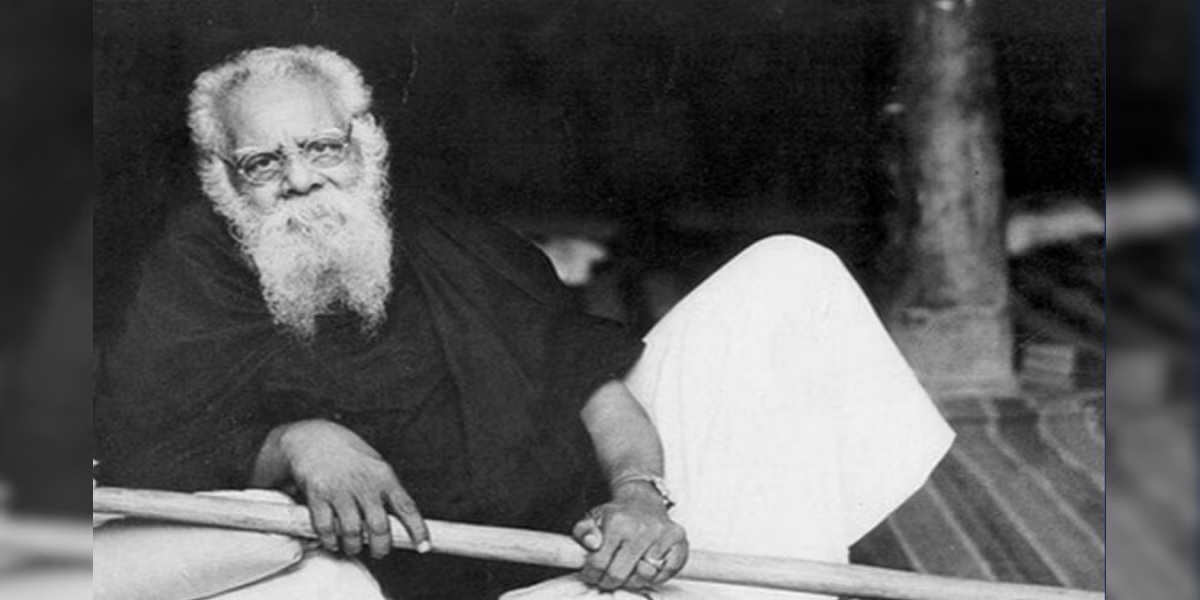Born on 17 September, 1879, in Erode, Periyar was a radical fighter against Brahminical dominance, caste and gender inequality and linguistic imposition. Since 2021, his birth anniversary is celebrated as 'Social Justice Day' in Tamil Nadu.
Published Sep 17, 2024 | 5:00 PM ⚊ Updated Sep 18, 2024 | 4:33 PM

Remembering Periyar on his 146th birth anniversary
Today marks the 146th birth anniversary of E.V. Ramasamy, popularly known as Periyar, a towering figure in the struggle against caste discrimination and linguistic imposition in pre-independent India.
Periyar’s ideas were a powerful expression of Tamil pride, especially in the face of perceived Hindi dominance. His visionary approach to social justice encompassed the abolition of caste identities, the fight against language imposition, and a progressive stance on feminism.
Tribute to Thanthai Periyar on his 146th Birth Anniversary. 💙 https://t.co/SCJiZMC5OB
— Lokesh Bag (@lokeshbag67) September 17, 2024
Periyar’s contributions to feminism are often under-appreciated, yet they were integral to his broader struggle for social equality. His ‘Self-Respect Movement’ not only sought to dismantle caste barriers but also championed women’s rights.
Periyar’s 1942 book, Pen Yen Adimaiyanal (Why Did Women Become Enslaved), addresses critical issues such as contraception, the choice of life partners, divorce, and remarriage, demonstrating his progressive views on gender roles.
During this period, Hindi was perceived as a tool of Brahminical dominance due to its origins in Sanskrit, a language traditionally reserved for forward-caste men.
Periyar’s ‘Self-Respect Movement’ sought to instil pride in the Dravidian heritage and resist what was seen as linguistic oppression. Fluent in Kannada, Telugu, and Tamil, Periyar’s linguistic skills underscored his commitment to Dravidian languages over Hindi.
The controversy over Hindi imposition began in 1937 under Rajaji’s rule, mandating Hindi in schools across the Madras Presidency. Periyar’s movement, characterised by protests, fasts, and numerous arrests, continued for three years and ultimately succeeded when the law was repealed in February 1940.
From a theist to an atheist and from a rebel to a leader, Periyar’s legacy transcends his lifetime, embodying the essence of Tamil identity and the struggle for justice. His impact remains a testament to his vision and relentless fight for equality.
In 1926, Periyar E.V. Ramasamy penned an article titled “Thamizhirkku Dhurogamum Hindi Baashaiyin Ragasiyamum” (Betrayal of Tamil and the Secret Behind Hindi) for his magazine Kudi Arasu, using the pen name Chithiraputhiran. This piece was the first Tamil-language article to critique the imposition of Hindi, marking a significant moment in the resistance against linguistic dominance.
“With a nationalist view, Gandhi tries to make Hindi the common language of the country. For that, he spends the people’s money. More than half of the money spent for Hindi is from non-Brahmins,” he wrote.
“Even though some of the non-Brahmins who learnt Hindi could have come forward to teach the language, they were not treated properly. How much money was spent for Sanskrit? It was used only to create discrimination as Brahmins, non-Brahmins and Sudras.”
“Are there enough schools to teach Tamil? Even the schools which teach the language are filled with Iyers, Iyengars, Acharyars, Raos and Sharmas. These Brahmins get the ancient palm manuscripts from non-Brahmins, translate in their language (sanskritised Tamil), publish it using the money collected from non-Brahmins and sell it to non-Brahmins for Rs. 10 and Rs. 25 and make a profit in lakhs,” Periyar wrote.
Periyar vehemently opposed the 1937 policy introduced by C. Rajagopalachari, which mandated Hindi as a compulsory subject in schools across the Madras Presidency. Periyar viewed this as an attack on Tamil cultural identity.
“Imposing Hindi on Tamil Nadu is like trying to suffocate a person with a pillow. It’s an attempt to erase our identity and impose alien culture,” he said.
On November 13, 1938, the Tamil Nadu Women’s Conference, led by Neelambigai Ammaiyar, convened to express women’s solidarity with the anti-Hindi agitation. During this pivotal event, E.V. Ramasamy was honoured with the title ‘Periyar,’ meaning ‘the great one’ or ‘elder,’ by the women of Tamil Nadu. In his address, Periyar articulated a powerful vision with his declaration, “Tamil Nadu is for Tamils.”
Addressing the conference, Periyar said, “We have gathered here to oppose their conspiracy of ruining our people’s self-respect by teaching Hindi to our children though they have themselves accepted that it is a North Indian language that exists for the sake of Aryan arts…Today a woman came up to me and said she was ready to go to jail. I was very happy on hearing her. Tomorrow, it will be known.”
“Only when the time comes, when Tamil women begin going to jail, good things will start happening to us…Women should come forward to cooperate with men in the struggle. In a struggle, there is no such thing like a specific job for men and another for women. Both are equal. So, if women also enter the Tamil struggle, very soon we will achieve a Tamil Nadu for the Tamils. Can’t all of you get together and fill an entire prison?”
(Compiled by Ananya Rao)
